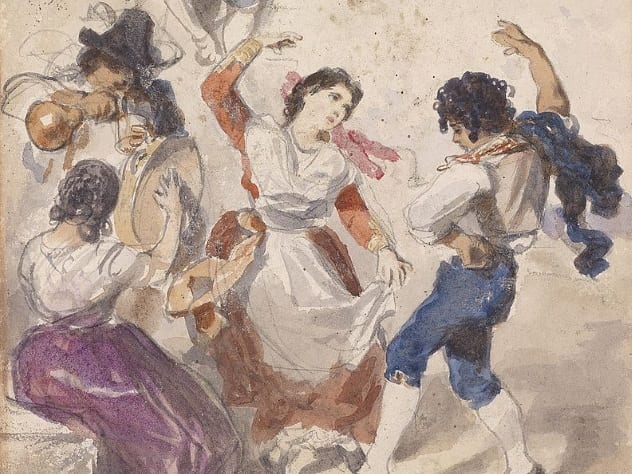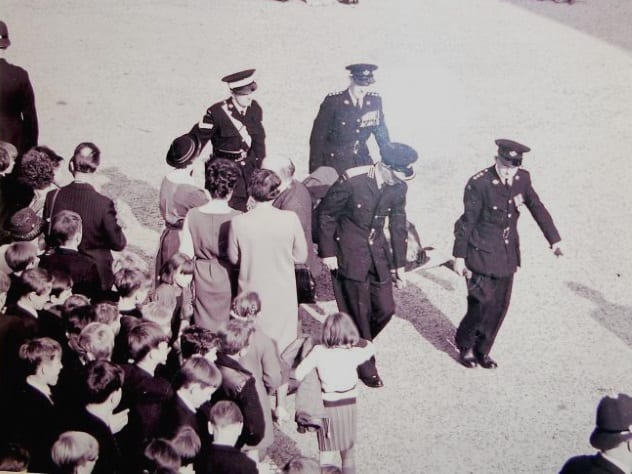 Mysteries
Mysteries  Mysteries
Mysteries  History
History 10 Surprising Stories About the Texas Rangers
 Humans
Humans 10 Philosophers Who Were Driven Mad by Their Own Theories
 Miscellaneous
Miscellaneous 10 Video-Game-Worthy Weapons and Armors from History
 Weird Stuff
Weird Stuff 10 Psychics Who Accurately Predicted Wartime Events
 The Arts
The Arts 10 Pieces of Art Inspired by a Broken Heart
 Health
Health 10 Science Fiction-Sounding New Medical Treatments
 History
History 10 Surprising Facts About the Father of Submarine Warfare
 Space
Space Ten Astonishing New Insights into Alien Worlds
 Weird Stuff
Weird Stuff 10 Bizarre Summer Solstice Rituals Still Practiced Today
 Mysteries
Mysteries Top 10 Haunting Facts About the Ghost Ship MV Alta
 History
History 10 Surprising Stories About the Texas Rangers
 Humans
Humans 10 Philosophers Who Were Driven Mad by Their Own Theories
Who's Behind Listverse?

Jamie Frater
Head Editor
Jamie founded Listverse due to an insatiable desire to share fascinating, obscure, and bizarre facts. He has been a guest speaker on numerous national radio and television stations and is a five time published author.
More About Us Miscellaneous
Miscellaneous 10 Video-Game-Worthy Weapons and Armors from History
 Weird Stuff
Weird Stuff 10 Psychics Who Accurately Predicted Wartime Events
 The Arts
The Arts 10 Pieces of Art Inspired by a Broken Heart
 Health
Health 10 Science Fiction-Sounding New Medical Treatments
 History
History 10 Surprising Facts About the Father of Submarine Warfare
 Space
Space Ten Astonishing New Insights into Alien Worlds
 Weird Stuff
Weird Stuff 10 Bizarre Summer Solstice Rituals Still Practiced Today
10 Disturbing Cases Of Mass Hysterical Contagion Like ‘Bird Box’
When Netflix released their feature film Bird Box in 2018, many viewers were left questioning what the “monster” was that drove everyone to suicide. One of the online theories is that the monster represented “mass hysterical contagion,” nowadays known as mass psychogenic illness (MPI), where a single individual suffers a psychogenic illness that spreads to a much larger group.
SEE ALSO: 10 Indications That Western Society Is Collapsing
Generally, women and girls will succumb to MPI more than men, as they are more likely to be triggered by another affected individual. Unlike the film suggests, nobody has reportedly died from the symptoms, which include hyperventilation, dizziness, panic, faintness, abdominal pain, sickness, headache, weakness, and itching.
These following real-life cases of mass hysterical contagion all ended nearly as quickly as they started. However, the sufferers will not easily forget just how frightening and disturbing such an outbreak can be.
10 The Twitching Teenagers

In October 2011, cheerleading captain Thera Sanchez woke up from a nap to find herself violently twitching and jerking. Two weeks later, a senior from the same school named Lydia Parker began humming and swinging her arms around involuntarily. Eventually, the numbers swelled from two to 20 people (mostly teenage girls) affected at Le Roy Junior/Senior High School, near Buffalo, New York.
Parents were becoming increasingly concerned that the tics were caused by the school’s water supply or that the playing fields were contaminated. However, the country’s leading environmentalists agreed there was nothing that would cause these symptoms.
According to Dr. Laszlo Mechtler, who treated 15 patients at the Dent Neurologic Institute, the symptoms were worsened by social media and press attention. Mechtler explained, “One thing we’ve learned is how social media and mainstream media can worsen the symptoms. The mass hysteria was really fueled by the national media, social media—all this promoted the worsening of symptoms by putting these people at the national forefront.”[1] By the end of the school term, many of the teenage girls who were affected had returned back to normal.
9 June Bug

In June 1962, 62 workers at a dressmaking textile mill in South Carolina began to show symptoms of nausea, dizziness, and “a breaking out over the body.” The workers believed that the outbreak was caused by bug bites after receiving a fabric shipment.
However, investigation by the US Public Health Service, concluded that there was no reliable evidence that the contagion had been caused by an insect. Instead, it was explained that working conditions in the 1960s were so poor that the stress spread both physically and mentally between coworkers. The “June Bug” itself also could have been manifested by the initial untrained medical staff, who were not familiar with such symptoms.
The June Bug outbreak can also be explained as a social contagion, which is where groups of people who have strong social ties are affected in the same way. The majority of the coworkers were women who were the main providers for their families, which meant spending many long hours together.[2]
8 Tarantism

In Italy from the 15th to the 17th century, tarantism was a form of hysteria that was associated with a bite from a tarantula. The term is derived from the town of Taranto, Italy. Those who were convinced they had suffered a tarantula bite would experience heightened excitability and restlessness. They would break out into a form of frenzied dancing which would allow them to be “cured.”
In 1693, a doctor in Naples suffered two tarantula bites in order to disprove that they would result in any of the typical tarantism symptoms. In front of six witnesses, he experienced no physical changes.
Tarantism gave rise to the tarantella, in which couples dance quickly and flirtatiously with each other. Composers Frederic Chopin, Franz Liszt, and Carl Maria von Weber have all written tarantella music.[3]
7 Tanganyika Laughter Epidemic

In 1962, the country of Tanzania (then known as Tanganyika) suffered a laughter epidemic that began with an outbreak at a girl’s school before spreading to the surrounding communities. More than 1,000 people were affected by chronic laughter that lasted several months. Symptoms also included hysterical crying, aimless running, and violent outbursts which could last anywhere between a few hours to more than two weeks. Fourteen schools were closed due to the epidemic.
It is believed that in this particular case, one schoolgirl fell ill with anxiety-induced laughter, which then set off other girls, and a chain reaction occurred throughout the region. Researcher Christian Hempelmann noted, “We build up some magical psychic pressure, and laughter lets us release it. Statistically in this case, this did not release anything. These people were suffering, expressing their suffering through that. Nothing got better because they laughed.”[4]
6 False Anthrax Alarms

On October 5, 2001, a letter that tested positive for anthrax killed the Sun newspaper’s picture editor Bob Stevens, and the world went berserk. The anthrax antibiotic, Cipro, was one of the fastest-selling drugs on the market, and in Dallas, an airplane was forced to make an emergency landing when potato chips that were crunched into the carpet were mistook for anthrax. In England, Canterbury Cathedral and the London Stock Exchange were evacuated due to false alarms. During the month of the anthrax fatality, there were four letters sent in the US mail that tested positive for anthrax but more than 3,000 cases of both false alarms and hoaxes.
Also during October, newspapers reported huge rises in sales as people were in desperate need of more information, and the media was blamed for overhyping the anthrax threats. Steve Caprus, executive producer of NBC Nightly News, stated that all journalists must “deal with facts—not hyping or being overly dramatic.”[5] Over the months that followed, five people died from inhaling anthrax, and 17 others were infected after exposure.
5 St. John’s Dance

In 1374, there was an outbreak of uncontrollable dancing in the streets of Aachen, Germany, which still baffles experts even to this day. The writhing of the bodies, sometimes referred to as “St. John’s Dance,” would drive sufferers to exhaustion.
In his 1888 book The Black Death and The Dancing Mania, Justus Friedrich Karl Hecker describes:
They formed circles hand in hand, and appearing to have lost all control over their senses, continued dancing, regardless of the bystanders, for hours together, in wild delirium, until at length they fell to the ground in a state of exhaustion. They then complained of extreme oppression, and groaned as if in the agonies of death, until they were swathed in cloths bound tightly round their waists, upon which they again recovered, and remained free from complaint until the next attack.[6]
4 Elsa Perea Flores School
Elsa Perea Flores School in Tarapoto, Peru, fell victim to an outbreak of hysteria affecting nearly 100 children at the school. During the summer of 2016, the children, mostly aged between 11 and 14, claimed they saw terrifying visions of a man in black trying to kill them and also experienced seizures. They experienced fainting attacks, muscular convulsions, delirium, and repeated screaming.
One pupil described her experience, saying, “It’s disturbing for me to think about it. It’s as if someone kept on chasing me from behind. It was a tall man all dressed in black and with a big beard and it felt like he was trying to strangle me.”[7] Another added, “Several children from different classrooms fainted at the same time. I got nauseous and started vomiting. I heard voices. A man in black chased me and wanted to touch me.” Locals put the hysteria down to demonic possession and claimed that the children must have been playing with an Ouija board before the attacks.
3 Blackburn Fainting Frenzy

During the summer of 1965, more than 300 people in Blackburn, England, began to suddenly faint with no prior symptoms. Princess Margaret was scheduled to visit the newly restored Blackburn Cathedral, and the crowds gathered in their thousands to await her arrival. Then, one by one, people began to collapse on the ground. The ambulance staff who attended the scene said the fainting was due to being stood around in the hot sun.
The following day, 98 pupils at St. Hilda’s Girls’ School also began to suddenly faint without explanation. They were rushed to the hospital, and mattresses were laid out in the hallways to cope with the sudden rise in patients. One ambulance driver recalled, “As fast as we took them away, new cases from classrooms in other parts of the school were being brought in.”[8]
A year later, a report in the British Medical Journal by a pediatrician and a London psychologist confirmed that this was a case a mass hysteria or, as noted, an “epidemic of over-breathing.”
2 Resignation Syndrome

A mystery illness observed in Sweden has been dubbed “resignation syndrome.” Children of asylum-seekers would withdraw completely, unable to open their eyes, speak, or even walk. Eventually, they did recover, but the illness baffled medical experts for more than two decades. Dr. Elisabeth Hultcrantz, a volunteer with Doctors of the World, revealed, “When I explain to the parents what has happened, I tell them the world has been so terrible that [their child] has gone into herself and disconnected the conscious part of her brain.”
Resignation syndrome was first reported in the 1990s. From 2003 to 2005, more than 400 cases were noted. Karl Sallin, a pediatrician at the Astrid Lindgren Children’s Hospital, said, “To our knowledge, no cases have been established outside of Sweden.” More recently, in 2016, Sweden’s National Board of Health stated that numbers had decreased; there were 169 cases that year.[9]
1 Coca-Cola Scare

In June 1999, Coca-Cola withdrew 30 million cans and bottles from the shelves in Belgium after more than 100 people claimed the product made them ill. It was reported throughout the country that many people, including children, became suddenly sick with “stomach cramps, nausea, headaches and palpitations” after drinking bottled Coca-Cola. After the Belgian government was swamped with complaints from citizens concerned about airborne toxins, an investigation took place. However, four members of Belgium’s Health Council suggested that the epidemic was a case of mass hysteria.
In a public letter, the health council stated, “It is probably significant that a company with such high visibility and symbolic image was involved in this episode. Besides the important role of the media, the scale of the outbreak may have been amplified by the radical measures taken by the health authorities, as well as deficient communication by the Coca-Cola company.”[10] Coca-Cola quickly recovered from the epidemic, and sales were back on the rise within weeks of the event.
Cheish Merryweather is a true crime fan and an oddities fanatic. Can either be found at house parties telling everyone Charles Manson was only 5’2″ or at home reading true crime magazines.
Twitter: @thecheish
Read about more crazy cases of mass hysteria on Top 10 Bizarre Cases of Mass Hysteria and Another 10 Bizarre Cases of Mass Hysteria.
![11 Lesser-Known Facts About Mass Murderer Jim Jones [Disturbing Content] 11 Lesser-Known Facts About Mass Murderer Jim Jones [Disturbing Content]](https://listverse.com/wp-content/uploads/2020/09/jonestown2-copy-150x150.jpg)
![10 Cases Of LGBTQ+ Persecution That Will Horrify You [DISTURBING] 10 Cases Of LGBTQ+ Persecution That Will Horrify You [DISTURBING]](https://listverse.com/wp-content/uploads/2019/10/proxy.duckduckgo-7-3-150x150.jpg)






